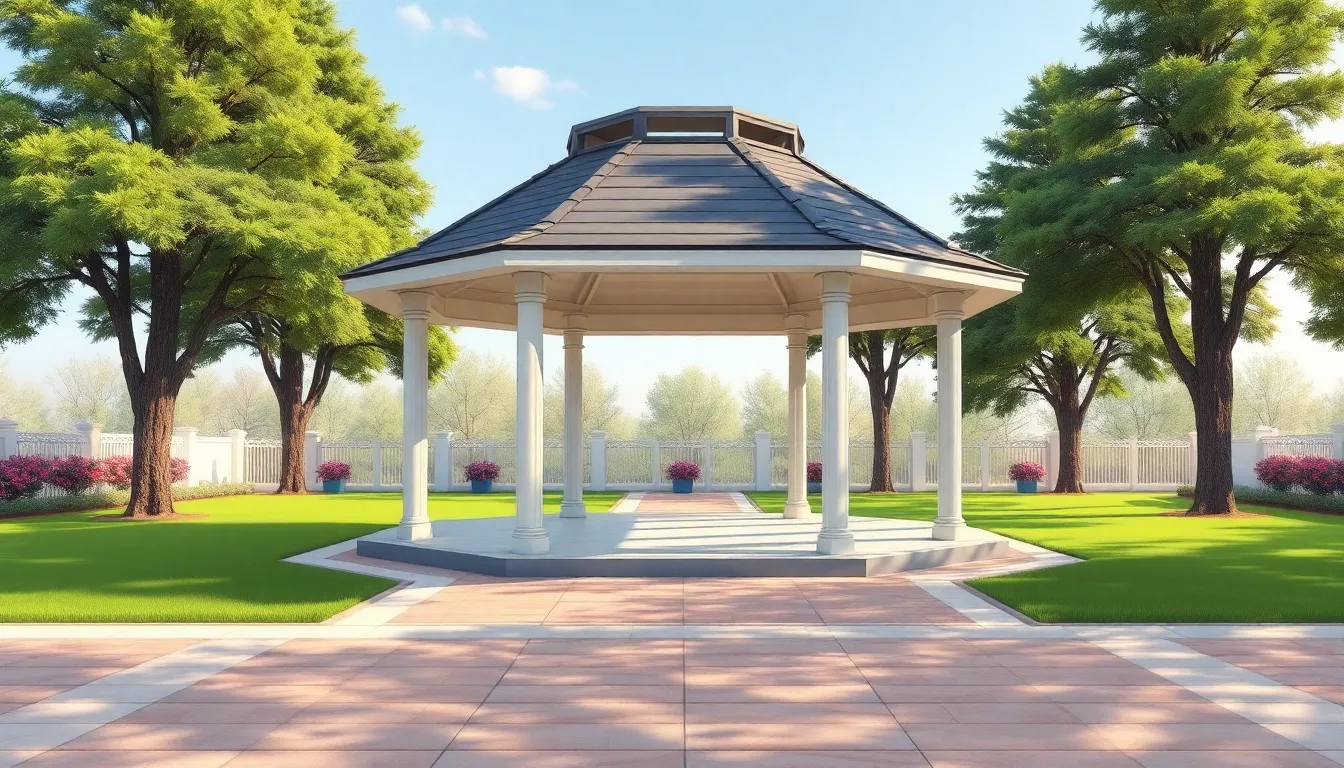When it comes to backyard bliss, gazebos are the crown jewels of outdoor living. But before diving into a world of relaxation and summer barbecues, there’s one crucial detail to consider: gazebo clearance. It’s not just about aesthetics; it’s about making sure your future hangout spot doesn’t turn into a game of limbo with low-hanging branches or awkwardly placed fences.
Gazebo Clearance
Gazebo clearance refers to the space required around a gazebo to enhance its functionality and aesthetic value. Proper clearance ensures users enjoy an unobstructed area free from distractions. It includes vertical space above, accounting for height requirements and avoiding low-hanging branches. Clear horizontal space accommodates movement and seating arrangements.
Adequate clearance prevents interference from surrounding structures, such as fences and walls. For example, maintaining at least 3 to 6 feet of clearance around the gazebo allows for easy access and visibility. This distance enhances safety by minimizing risks associated with falling branches or debris.
Understanding local zoning laws is critical to ensuring compliance with any regulations regarding gazebo placement. Local codes often dictate minimum distances from property lines and structures, influencing available clearance. Gazebo clearance also encompasses considerations of the surrounding landscape, such as trees and shrubs, which can impact light and airflow.
For optimal enjoyment, it’s essential to factor in additional space for furniture and landscaping features. Homeowners benefit from planning seating arrangements, plants, and pathways during the installation process, ensuring a harmonious flow around the gazebo.
Evaluating the purpose of the gazebo aids in determining the necessary clearance. Social gatherings or quiet retreats may require different spatial needs. Clear communication about these requirements fosters a more enjoyable outdoor living experience.
Importance of Proper Gazebo Clearance

Proper gazebo clearance enhances outdoor spaces significantly. It ensures both functionality and aesthetic appeal while promoting safety.
Benefits of Adequate Clearance
Adequate clearance improves accessibility around the gazebo. Clear pathways enable smooth movement for guests and easy navigation for furniture placement. Increased vertical space allows for natural light, creating a more inviting atmosphere. It also prevents foliage from encroaching into the space, reducing maintenance efforts. Visibility increases, allowing users to enjoy scenic views without obstruction. Regulatory compliance becomes simpler with clearly defined boundaries, ensuring adherence to local zoning laws.
Consequences of Insufficient Clearance
Insufficient clearance can lead to safety hazards. Low-hanging branches may cause injuries, particularly during windy conditions. Restricted movement creates challenges when arranging furniture, diminishing the gazebo’s usability. Obstructive structures can block light and views, making the space less enjoyable. Maintenance becomes burdensome, as vegetation requires frequent trimming to maintain the area. Furthermore, noncompliance with local regulations may result in fines or mandated modifications, complicating ownership.
Factors to Consider When Determining Gazebo Clearance
Several factors influence gazebo clearance, impacting both functionality and safety. Understanding these factors contributes to an effective outdoor space design.
Local Building Codes
Local building codes dictate various clearance requirements alongside zoning regulations. These codes provide specific measurements for horizontal and vertical clearance around structures. Compliance with all local regulations minimizes risks of fines and ensures safety. For example, certain areas might require a minimum clearance of 5 feet from property lines. Homeowners should check with local authorities to ensure adherence.
Site-Specific Conditions
Site-specific conditions heavily affect gazebo clearance. Terrain variations, like slopes or natural barriers, can dictate the need for additional clearance. Considerations such as surrounding trees and existing structures also play a crucial role. For instance, if there are low-hanging branches, increasing vertical clearance protects against damage. Evaluating soil conditions and drainage patterns further informs necessary spacing adjustments for varying weather conditions.
How to Measure Gazebo Clearance
Measuring gazebo clearance involves determining both vertical and horizontal space around the structure. Achieving accurate measurements enhances functionality and safety levels.
Recommended Measurement Techniques
Start by measuring the vertical clearance first. Use a tape measure to check the distance from the ground to the lowest point of overhanging branches. Next, assess horizontal space; measure at least 3 to 6 feet from the gazebo’s edges to any surrounding structures or obstacles. Consider using a rope or string to visualize the clearance space. Mark the intended area with stakes to ensure clarity. Evaluating pathways for movement is essential, so measure the path width needed for furniture placement. Ensure to account for additional clearance where possible, especially if the gazebo serves multiple purposes.
Tools Required for Measurement
Essential tools for measuring gazebo clearance include a tape measure, which provides accurate distance readings. A level is also useful to determine vertical drops, ensuring an even layout. Stakes will help mark the desired clearance area clearly. A notepad can assist with recording measurements for future reference, and a string or rope can visually outline spaces. Additionally, a smartphone app may aid in planning and visualizing layouts. Consider using a compass for understanding sunlight angles, as this can impact the gazebo’s orientation and surrounding landscape. Collecting these tools provides a comprehensive approach to measuring gazebo clearance effectively.
Conclusion
Ensuring proper gazebo clearance is vital for creating an enjoyable outdoor living space. It enhances safety accessibility and aesthetic appeal while minimizing maintenance efforts. By understanding local zoning laws and evaluating site-specific conditions he or she can effectively plan for the necessary clearance around the gazebo.
Incorporating adequate vertical and horizontal space allows for clear pathways and unobstructed views. This thoughtful approach not only fosters a harmonious outdoor environment but also encourages compliance with regulations. Ultimately investing time in planning and measuring gazebo clearance leads to a more functional and inviting space for relaxation and entertainment.



